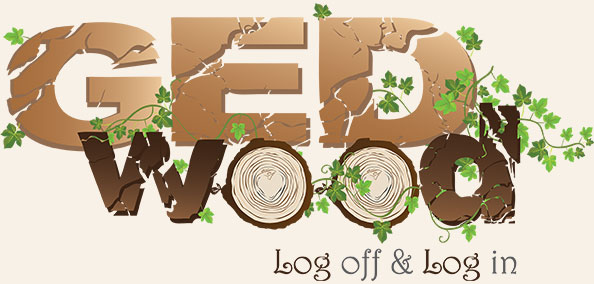Wood Species Profiles
Sycamore (Acer Pseudoplatanus)
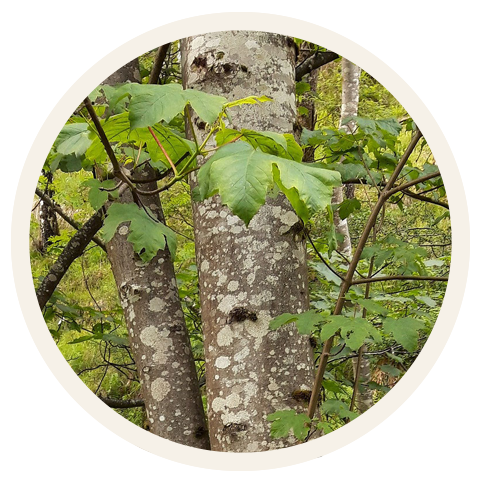
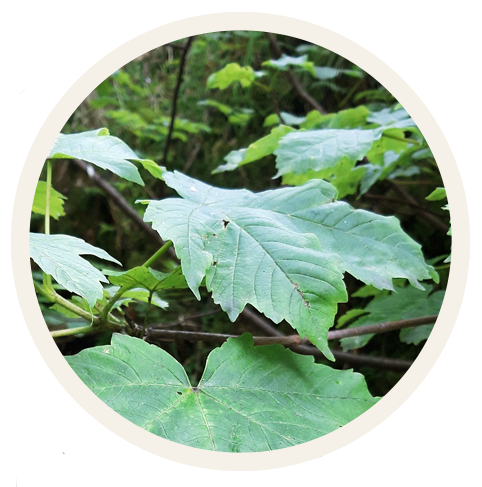
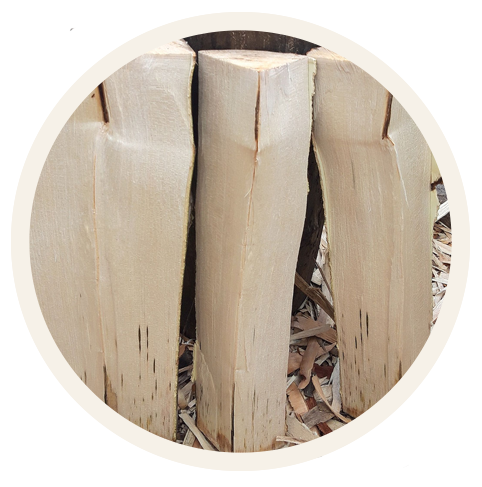
Sycamore may have been introduced to the UK, first in England, by the Romans. More widespread planting occurred in the 1700s and the earliest reports of the species naturalising in the UK date from the mid 1800s. Sycamore grows fairly abundantly throughout Speyside and can thrive both in upland and lowland settings often growing in poor soil conditions. It can grow to 35m and can live for 400 years. Sycamore is usually a straight grained timber, but sometimes it becomes more valuable when the grain is wavy as this produces an attractive 'fiddleback' figure, so called as it was often used for the backs of violins. The soft straight grained wood has a lovely creamy colour with a natural lustre finish making it an easy timber to cleave and carve out. Occasionally I come across a fallen mature tree whereby the grain has darkened to a light golden colour due to its exposure to light - these make an attractive tumbler.
Bark: usually is dark pink-grey and smooth when young, but becomes cracked and develops small plates with age.
Leaves: palmate leaves measure 7-16cm and have five lobes. Leaf stalks of younger trees are characteristically red.
Flowers: small, green-yellow and hang in spikes, or 'racemes'.
Fruits: after pollination by wind and insects, female flowers develop into distinctive winged fruits known as samaras.
Ecological value: Sycamore is attractive to aphids and therefore a variety of their predators, such as ladybirds, hoverflies and birds. The leaves are eaten by caterpillars of a number of moths, including the sycamore moth, plumed prominent and maple prominent. The flowers provide a good source of pollen and nectar to bees and other insects, and the seeds are eaten by birds and small mammals.
Folklore: There is very little folklore associated with sycamore, as it is an introduced species. However, in Wales, sycamore trees were used in the traditional craft of making 'love spoons'. In some parts of the UK the winged seeds are known as 'helicopters', and used in flying competitions and model-making by children.
Timber value: A much under utilised tree considering its widespread abundance in Scotland. Sycamore timber is hard and strong, pale cream and with a fine grain. It is used for making furniture and kitchenware as the wood does not taint or stain the food. Sycamore is excellent for furniture and internal joinery and for making domestic utensils like rolling pins and chopping boards.
Ash (Fraxinus Excelsior)
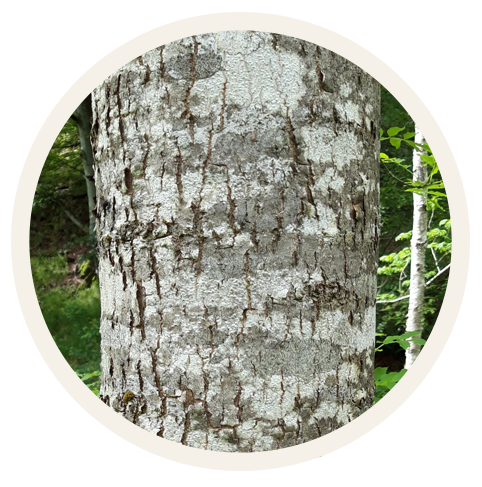
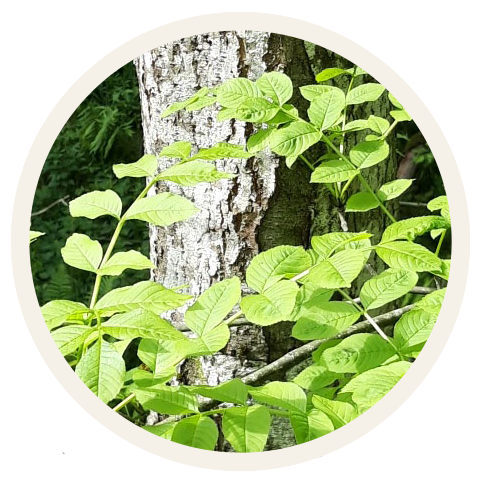
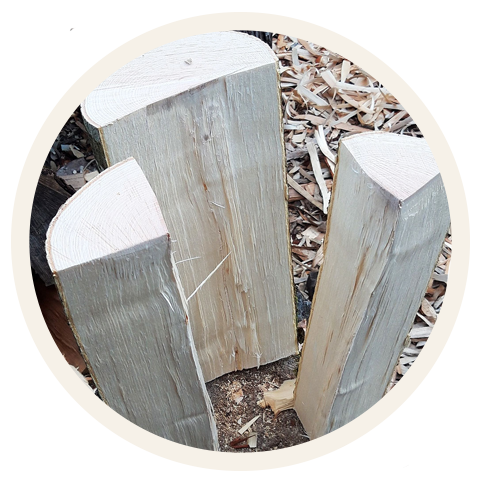
This is a very common tree in Speyside. Ash thrives in fertile soil and natural regeneration can be prolific after an opening in the tree canopy allows light onto the forest floor. Ash trees can live to a ripe old age of 400 years and even longer if coppiced. Mature ash trees can reach a height of 35m making it one of the 3 tallest trees native to Scotland. The bark is pale brown to grey, which fissures as the tree ages. Easily identified in winter by smooth twigs that have distinctively black, velvety leaf buds arranged opposite each other. Ash for me is probably the most versatile timber to use in green woodworking. Mainly due to its strength and toughness. Amongst other things, I can make gates, stools, chairs and whisky tumblers. It has a good straight attractive grain making it easy to cleave. The heartwood is usually light in colour as is the sapwood but sometimes I come across ash with a dark brown heartwood known as olive ash (or manna ash) which makes a lovely two tone finish on my whisky tumblers. Although it is a harder wood to carve than most others it is worth the effort for the end result!
Leaves: comprising of 3-7 opposite pairs of light green, oval leaflets with long tips .There is an additional singular 'terminal' leaflet at the end. The leaves can move in the direction of sunlight, and sometimes the whole crown of the tree may lean in the direction of the sun. Another characteristic of ash leaves is that they fall when they are still green.
Flowers: ash is dioecious, meaning that male and female flowers typically grow on different trees, although a single tree can also have male and female flowers on different branches. Both male and female flowers are purple and appear before the leaves in spring, growing in spiked clusters at the tips of twigs.
Fruits: once the female flowers have been pollinated by wind, they develop into conspicuous winged fruits, or 'keys', in late summer and autumn. They fall from the tree in winter and early spring, and are dispersed by birds and mammals.
Ecological value: Ash trees make the perfect habitat for a number of different species of wildlife. The airy canopy and early leaf fall allow sunlight to reach the woodland floor, providing optimum conditions for wildflowers such as dog violet, wild garlic and dogs mercury, and consequently insects such as the rare and threatened high brown fritillary butterfly.
Bullfinches eat the winged seeds and woodpeckers, owls, redstarts and nuthatches use the trees for nesting. Because trees are so long lived, they support deadwood specialists such as the lesser stag beetle. Often ash is accompanied by a hazel understory, providing the perfect conditions for dormice.
Ash bark is often covered with lichens and mosses. The leaves are an important food plant for the caterpillars of many species of moth, including the coronet, brick, centre-barred sallow and privet hawk-moth.
Folklore: The ash tree was thought to have medicinal and mystical properties and the wood was burned to ward off evil spirits. In Norse Viking mythology, ash was referred to as the 'Tree of Life'. Even today it is sometimes known as the 'Venus of the woods'. In Britain we regarded ash as a healing tree.
Timber value: People have used ash timber for years. It is one of the toughest hardwoods and absorbs shocks without splintering. It is used for making tools and sport handles, including hammers, axes, spades, hockey sticks and oars. An attractive wood, it is also used for furniture. Ash coppices well, which traditionally provided wood for firewood and charcoal.
Goat Willow (Salix Caprea)
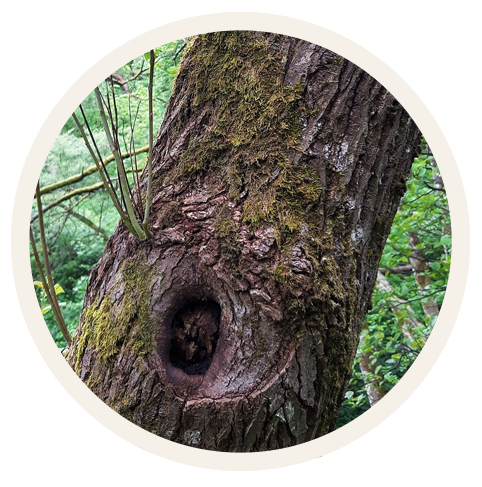
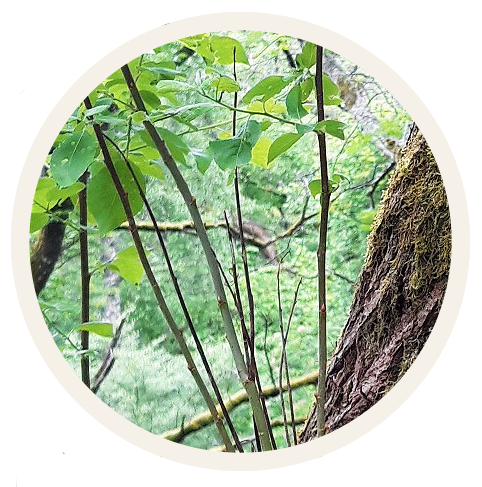
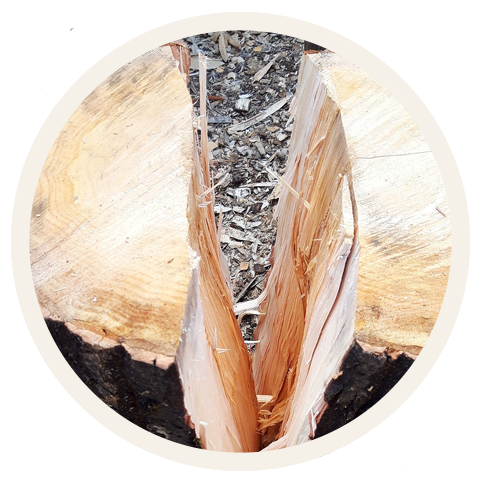
It is found growing in woodland, hedgerows and scrub, and on damper, more open ground such as near lakes and streams. Mature trees grow to 10m and can live for 300 years. A very common tree found growing in Speyside. A very straight grained soft timber easy to split and carve with a lovely aroma and notes almost reminiscent of almonds. Goat willow has a very attractive two tone grain of white sapwood and a lovely light orange heartwood making it a lovely feature in my malt whisky tumblers.
Bark: The bark is grey-brown and develops diamond-shaped fissures with age.
Leaves: unlike most willows, the leaves are oval rather than long and thin. They are hairless above, but with a felty coating of fine grey hairs underneath, and have a pointed tip which bends to one side.
Flowers: goat willow is dioecious, meaning male and female flowers grow on separate trees, in early spring. Male catkins are grey, stout and oval, which become yellow when ripe with pollen. Female catkins are longer and green.
Fruits: once pollinated by wind, female catkins develop into woolly seeds. Most willows can also propagate themselves by lowering their branches to the ground, which then develop roots..
Ecological value: Goat willow foliage is eaten by caterpillars of a number of moths, including the sallow kitten, sallow clearwing, dusky clearwing and lunar hornet clearwing. It is also the main food plant for the purple emperor butterfly.
Catkins provide an important early source of pollen and nectar for bees and other insects, and birds use goat willow to forage for caterpillars and other insects.
Folklore: All willows were seen as trees of celebration in biblical times, but this changed over time and today willows are more associated with sadness and mourning. Willow is often referred to in poetry in this way, and is depicted as such in Shakespeare's Hamlet, with Ophelia drowning near a willow tree. In northern areas, willow branches are used instead of palm branches to celebrate Palm Sunday.
Timber value: Goat willow timber is a soft and straight grained wood.Unlike most willows, its brittle twigs are not suitable for weaving, but traditional uses for its wood included clothes pegs, while the foliage was used as a winter feed for cattle. The wood also burns well and makes a good fuel.
Traditionally willows were used to relieve pain, and the painkiller AspIrin is derived from salicin, a compound found in the bark of all Salix species.
Rowan (Sorbus Aucuparia)
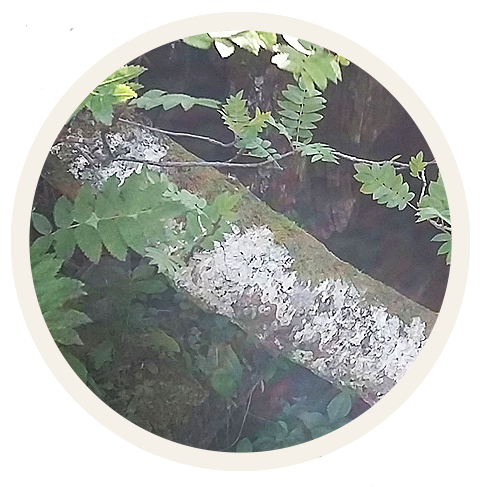
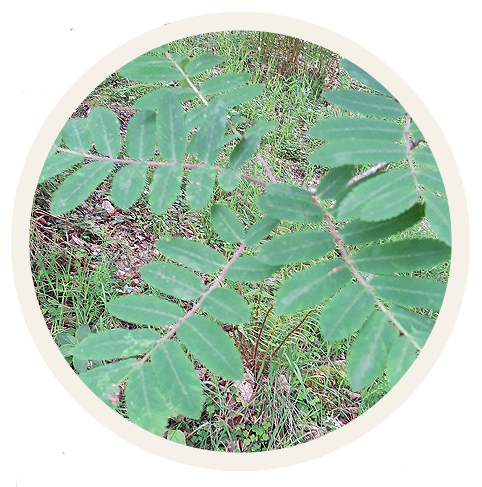
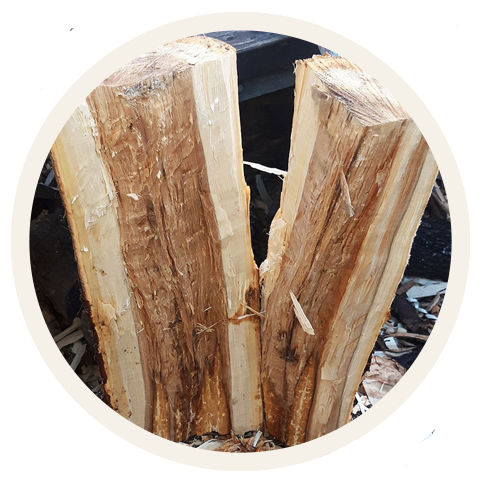
The rowan tree is native throughout Scotland. Also known as the mountain ash because it is able to survive high altitudes, and also because its pinnate leaves are very similar to those of the common ash, this tree is well known for its stunning white spring flowers followed by striking bursts of bright red berries in late summer to early autumn. It’s a deciduous tree known to grow up to 15 metres in height and to live up to 200 years. Mature trees can grow to 15m in height and can live for up to 200 years. Occasionally I come across a fallen tree with a wide enough girth to make tumblers from, with striking results as the dark brown heartwood contrasting with the light cream sapwood is visually stunning.
Leaves: Leaves are pinnate and turn from green to yellow in autumn. There are 5-8 pairs of long, oval serrated leaflets together with one terminal leaflet at the end. Leaf buds are purple and hairy.
Flowers: Rowan flowers appear in dense clusters from May to June with each cluster presenting five creamy white petals.
Fruits: Rowan fruits are prominent, scarlet berries that appear in late summer to early autumn.
Ecological value: Moth caterpillars are particularly partial to rowan leaves, especially the autumn green carpet moth and the Welsh wave moth. Apple fruit moth caterpillars enjoy rowan berries, as do numerous birds including the blackbird, song and mistle thrush, redstart, redwing, waxwing and fieldfare. The flowers of the tree are rich in pollen and nectar, so attractive to bees and other pollinating insects.
Folklore: Traditionally, rowan was planted beside cairns, stone circles and homesteads to protect against witches and was used in many rituals to ward off evil. The bright scarlet red berries were considered effective in fighting evil, which is why this tree has long been associated with witches and magic. The Celtic name for the rowan tree is ‘fid na ndruad’, meaning ‘wizards tree’.
Timber uses: The pale, yellowy-brown wood of the rowan tree with its distinctive deep-brown heartwood is sometimes used in furniture making, wood-crafting and engraving. In the past it was used for barrel hoops and archers bows. There is increasing commercial interest in the berries, which have culinary and medicinal uses. The fruits are particularly rich in Vitamin C.
Alder (Alnus Glutinosa)
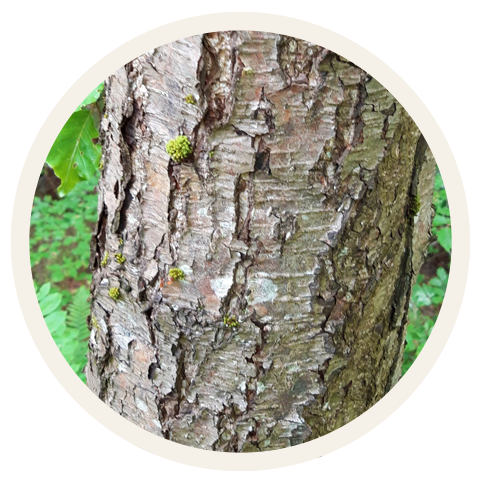
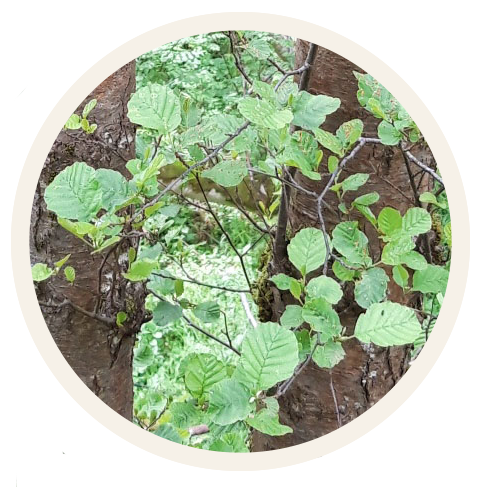
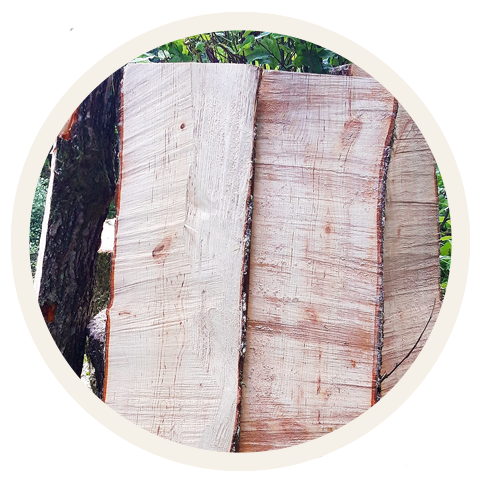
The common alder is very widespead here in Speyside. Its natural habitat is moist ground near rivers, and also thrives in damp, cool areas where its roots help to prevent soil erosion. But It can also grow in drier locations and sometimes occurs in mixed woodland and on forest edges. Most of my alder comes from the old former railway embankments.
Alder when first cut can be a rather intense shade of orange but this fades over time until the timber becomes a light orange - brown colour. It has a fine texture and is mostly straight grained making it easy to cleave. But its most noticeable feature being the dark streaks (medullary rays) that run through the grain of the timber - an attractive feature on the whisky tumblers! It's such an easy light wood to carve out whisky tumblers from and dries very quickly making it a fast turnaround for producing stock.
Mature trees can reach a height of around 25mtrs and live to around 60 - 70 years. The bark in mature trees is dark and fissured and is often covered in lichen. Twigs have a light brown spotted stem which turns a reddy purple towards the top - making it a good diagnostic for winter tree identification. Alder fixes nitrogen in its root nodules, giving it the ability to grow in poor soils and was one of the first trees to colonise Britain after the last ice age. As a result of this, alder improves the fertility of the soil where it grows, and as a pioneer species, it helps provide additional nitrogen for the successional species which follow.
Leaves: the purple or grey leaf buds form on long stems and the 3–9cm long dark green leaves are racquet-shaped and leathery, with serrated edges. The leaf tip is never pointed and is often indented.
Flowers: are on catkins which appear between February and April. Both male and female flowers are found on the same tree. Male catkins are yellow and pendulous, measuring 2–6cm. Female catkins are green and oval-shaped, and are grouped in numbers of three to eight on each stalk.
Fruits: once pollinated by wind, the female catkins gradually become woody and appear as tiny, cone-like fruits in winter. They open up to release seeds, which are dispersed by wind and water.
Ecological value: Alder is the food plant for the caterpillars of several moths, including the alder kitten, pebble hook-tip, the autumnal and the blue bordered carpet moth. Catkins provide an early source of nectar and pollen for bees, and the seeds are eaten by the siskin, redpoll and goldfinch.
The wet conditions found in alder woodland are ideal for a number of mosses, lichens and fungi, along with the small pearl-bordered fritillary and chequered skipper butterflies, and some species of crane fly. Alder roots make the perfect nest sites for otters too!
Folklore: Wet and swampy, alder woods, or carrs, were thought to have a mysterious atmosphere. The green dye from the flowers was used to colour and camouflage the clothes of outlaws like Robin Hood, and was thought to also colour the clothes of fairies. When cut, the pale wood turns a deep orange, giving the impression of bleeding. As such, many people feared alder trees and the Irish thought it was unlucky to pass one on a journey.
Timber uses: Soft and porous, alder wood is only durable if kept wet, and its ability to withstand rot under water. Historically it has been used in the construction of boats, sluice gates and water pipes, and much of Venice is built on alder piles. Today alder wood is used to make timber veneers, pulp and plywood. Alder coppices well and the wood makes excellent charcoal and gunpowder. Alder used to be the preferred wood to make clogs, and it was said that a few alder leaves placed in the shoes before a long journey would cool the feet and prevent swelling.
Wild Cherry (Prunus Avium)
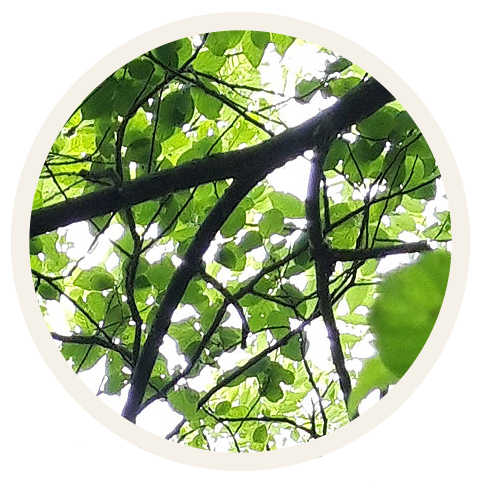
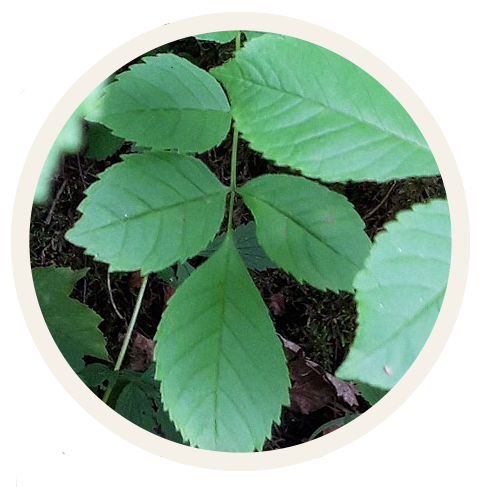
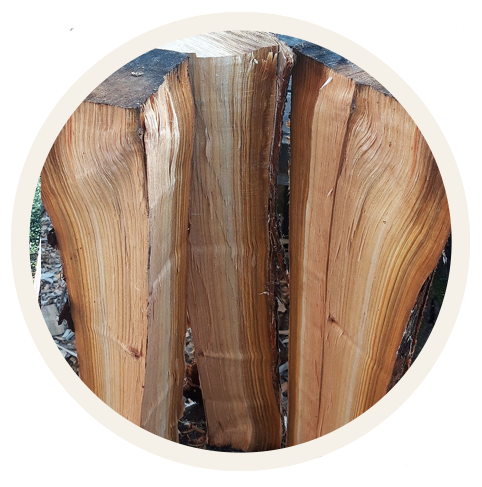
The wild Scottish cherry, locally known as gean, is a well loved tree that features frequently in Highland folklore. Not as common as my other woods used for tumbler making. It can be found in mixed broadleaved woodland where its blossom stands out in snow white patches in spring. Wild cherry can have some beautiful streaks of colour through it with a distinct darker heartwood and paler sapwood with occasional green flecking which makes a very attractive feature in my whisky tumblers.
Bark: Has smooth glossy purplish-brown bark with horizontally elongated pores. The bark consequently peels in horizontal papery strips.
Leaves: Oval, green and toothed with pointed tips, measuring 6–15cm with two red glands on the stalk at the leaf base. They fade to orange and deep crimson in autumn.
Flowers: Cherry trees are hermaphrodite, meaning the male and female reproductive parts are found in the same flower. Flowers, measuring 8–15mm across appear in April and are white and cup-shaped, with five petals. They hang in clusters of two to six.
Fruits: After pollination by insects, the flowers develop into globular, hairless, deep-red cherries.
Ecological value: The spring flowers provide an early source of nectar and pollen for bees; while the cherries are eaten by birds, including the blackbird and song thrush; as well as mammals, such as the badger, wood mouse, yellow-necked mouse and dormouse. The foliage is the main food plant for caterpillars of many species of moth, including the cherry fruit and cherry bark moths, the orchard ermine, brimstone and short-cloaked moth.
Folklore: The wild cherry is thought to have had enigmatic qualities according to Highland folklore and in those days to come across a wild cherry tree was considered fortunate. Wild cherry folklore is also associated with the cuckoo. It was said that this bird cannot stop singing until it has eaten three good meals of cherries. In Scotland, the wild cherry is known as ‘gean’. This is thought to have been derived from ‘guigne’, a French word for cherry.
Timber value: Traditionally, cherries were planted for their fruit and also their wood which was used for making cask hoops and vine poles. The sticky resin was thought to promote a good complexion and eyesight, and help to cure coughs. These days, cherry wood is used to make decorative veneers and furniture. The wood is hard, strong and honey-coloured, and can be polished to a good, shiny brown. The wood burns well and produces a sweetly scented smoke, similar to the scent of its flowers.
Sources:
Harris, E. and Harris, B. Readers Digest Field Guide to the Trees and Shrubs of Britain, 1981
https://www.woodlandtrust.org.uk/visiting-woods/trees-woods-and-wildlife/
http://ashs.co.uk/



